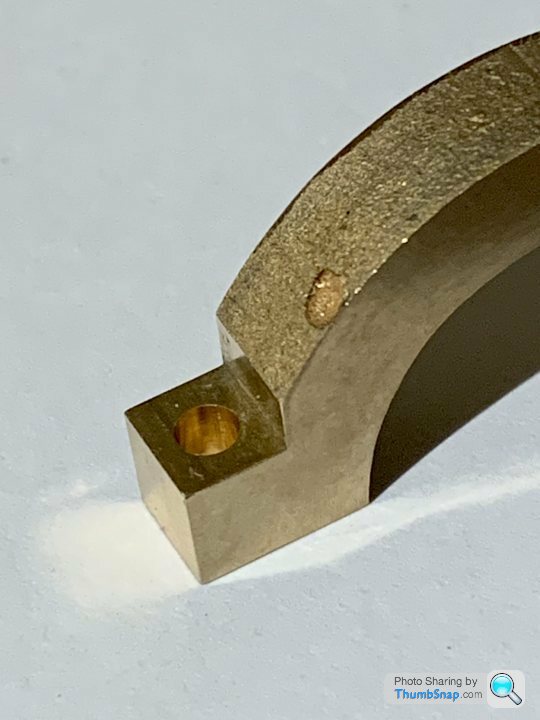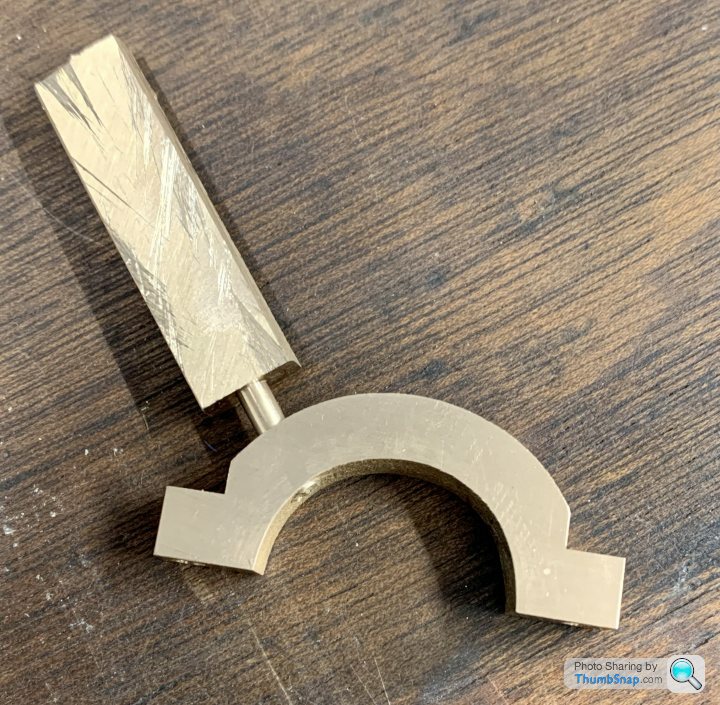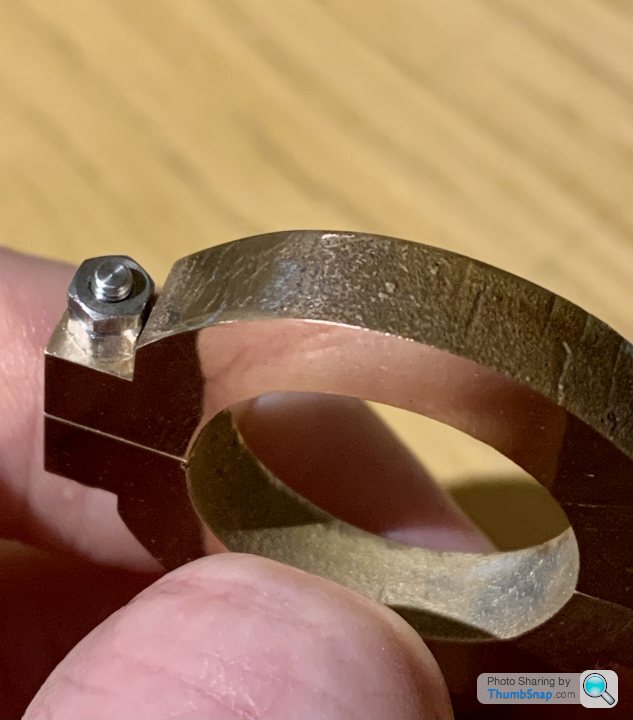Member postings for Dr_GMJN
Here is a list of all the postings Dr_GMJN has made in our forums. Click on a thread name to jump to the thread.
| Thread: Stuart Twin Victoria (Princess Royal) Mill Engine |
| 29/03/2023 23:04:55 |
Still struggling a bit with the straps - a bit of fettling needed tonight, but I think I’m getting there. |
| Thread: Small Ground (GT) Inserts? |
| 29/03/2023 13:35:13 |
I wonder if the left-hand turning tool with the diamond insert gives 45 degrees for chamfering when set perpendicular to the bed? I'm not at home at the moment, but that might be an option, albeit making the tool holder more likely to hit the chuck at small workpiece projections. |
| 29/03/2023 13:29:11 |
Posted by JasonB on 29/03/2023 13:09:51:
Most small parts I just run a fine file against the corner of the rotating work to remove any burrs. I do have a 6mm HSS tool that lives in it's own QCTP holder that gets used if I need a larger chamfer, just ground 45deg on each side to meet at a 90deg point.
Yes, I often do the same, but for getting things consistent (e.g. the small chamfers on the P.R. eccentric fitted bolts), I try to use a tool not a file. I'm not yet skilled enough to get really consistent results that way, and where there are multiple pieces close together, inconsistent features can look a bit naff. |
| 29/03/2023 13:25:18 |
Posted by peak4 on 29/03/2023 13:09:08:
Posted by Dr_GMJN on 29/03/2023 12:21:14:
A Google search doesn't give any results for what I assume is the correct designation: SCGT 06(T)304. Any ideas? Thanks.
As with other folk above, I've had a good look around, including Chinese sites and failed to find SCGT060204 anywhere, so I guess either you need to move to a larger holder, which as you say defeats the object. Thanks Bill, yes that's why I put the "T" in brackets. Either way, there's nothing out there. I do have the diamond shaped GT inserts, which I've put in my L/H, R/H and straight holders. They are my "go-to" tools for most materials these days. I just thought It would be nice to have a 45 degree chamfer tool in the same series though, since I already have the holder. |
| 29/03/2023 12:50:20 |
Posted by JasonB on 29/03/2023 12:28:08:
Does not seem to be much about in SCGT060204, most seem to start with the larger 09 size
Yes, I can't find anything at all. It's a shame because it would be great for smaller workpieces. I guess I could get the larger holder, but that kind of defeats the object. |
| 29/03/2023 12:21:14 |
All, a couple of years ago I was advised to try using ground GT inserts to get a decent finish on something or other (I think it was the stainless or silver steel valve rod on the Stuart 10V). Since then I've found that they give an excellent finish on most small components, in a range of materials from stainless steel to aluminium. I have an ArcEuro square tool holder ( ARC SSDC-N 45° Turning Tool Holders - Arc Euro Trade I'd like to use ground inserts in this tool, but Arc only seem to supply them in 9.525mm side lengths ( SCGT Square Uncoated Carbide Inserts - Arc Euro Trade A Google search doesn't give any results for what I assume is the correct designation: SCGT 06(T)304. Any ideas? Thanks.
|
| Thread: Stuart Twin Victoria (Princess Royal) Mill Engine |
| 26/03/2023 14:42:42 |
I got the bolts made today:
Unfortunately the I don't think there's enough room to make a flanged boss for the eccentric rod, so I'll stick with the rectangular ones as per the article. |
| 26/03/2023 14:39:09 |
Posted by Weary on 26/03/2023 11:36:26:
Re: your 'plug' to cover strap-blemish: How about drilling all the way through a small size (say 1mm), then drilling the 'plug' size part way through. This would allow flux to escape down the 'pilot vent' and save re-machining inside the straps? The pilot hole would be invisible once assembled. Additionally I note that your flaw appears to be very close to the strap-edge = watch for drill break-through! Maybe worth using a suitable sized end-mill as a drill? Regards, Phil Thanks Phil, yes the idea is to use the end mill again - I realise it's close to the edge, but at least the flaw tapers, so the very edge of it might get machined away anyway. I'll see how it goes with the milling - I might just mill right through it it's possible. As you say whatever the inner end looks like, won't be visibe anyway.
|
| 26/03/2023 09:06:45 |
Posted by JasonB on 26/03/2023 07:07:31:
You could do, just be careful that any hot flux in the bottom of the hole does not pop the plug out. I thought you were going to just bolt it together for boring?
I think the bearing pedestals are the same material as the straps, so I guess I could bore right through and plug to avoid any push-back, then machine? |
| 25/03/2023 21:50:24 |
Would it be possible to solder the plug in place rather than Loctite? I guess I’ll be soldering the joint faces anyway, so I could do the plug at the same time before final machining. |
| 24/03/2023 07:19:20 |
I don’t have any off-cuts, but I wonder if it’s the same material as the main bearing pedestals that I no longer need? The other thing is I’m not that keen on the flat bar eccentric rods. I’ve seen some with parallel round bar screwed into a flat plate with a boss for the rod, the plate is in turn bolted to the eccentric. If I got some of the right diameter rod I might consider doing that, then I’d have the rectangular tail off-cuts spare. I might see how much material I’d have for a pad on the eccentrics and take it from there.
|
| 23/03/2023 21:19:22 |
Got the main flat surfaces completed on both straps, and machined the holes. Everything lines up fine, and all but one of the holes look to be good quality (at least when assembled using a twist drill as a spigot). The remaining hole has a slight bulge, but it’s cylindrical over about 270 degrees so it should be ok at least in function. I don’t think the holes are worth reaming after all: |
| 23/03/2023 09:44:06 |
Hopper, yes the hole centres on the first strap are now OK, although one is slightly 'bulged'. It would be good to ream them as a pair (as Jason suggested initially), but obviously it's not great because they are now separate pieces. Since I already have a 1/8" reamer, I can't see a disadvantage? I will bore the central hole once the fitted bolts are in place and tight. I'm going to mill the holes in the second one later, because I can see no reason why drilling again would give better results this time. Unfortunately the mill isn't long enough to go through both at once, but the hard stop method worked fine. |
| 23/03/2023 08:59:53 |
Thanks Hopper. I think I'd like to try the fitted bolts - if nothing else it's another bit of machining to try. I do already have a 1/8" reamer, so I wouldn't mind trying that. I've got a 3mm hole currently so it should be OK. Is the best way of going about it to align the faces and one end face on a surface plate, temporarily bolt one side and then ream?
Thanks. |
| 20/03/2023 23:03:20 |
So I had a bit of time tonight, and tried the end mill and hard-stop method: |
| 20/03/2023 13:57:01 |
Posted by JasonB on 20/03/2023 13:03:45:
I would do the half without the lug up the other way which will keep matching sides against the rear fixed jaw
OK. I might move the hole centres in by 0.25mm so if there’s a slight mis-match of the outer faces, I’ve got something to machine off if necessary. I’ll just hope for the best with the main faces. |
| 20/03/2023 11:44:12 |
Posted by JasonB on 20/03/2023 10:10:37:
Don't be in such a rush to get a new casting. As you are going for fitted bolts you can make then to fit what is needed to get over the problem. If you set up each half and plunge cut with a 3mm or 1/8" endmill in the correct position that will pull the hole back to where it should be. You then just make your fitted bolts with a 3mm or 1/8" shank and still put the 7BA thread on the end and size the head to your original hex A/F Thanks Jason. That was my Option 1) above, but I assumed that the potential issue with re-boring the holes after splitting would be a mis-match of the faces and/or sides (since the point of a fitted bolt is to maintain precise alignment)? Obviously the centre hole isn't a problem because it will be bored. I was going to make the bolts similar to what you 've shown, but with a square head which will be a good fit against the milled flat. I do have a new 3mm end mill. Since it is short, I'd have to bore each hole in turn, from the mating face. The only way I could do this accurately I think is by using an x-axis stop for the vice, where the parts are pushed against it, clamped, and the hole bored with everything locked apart from the z-axis. I'd have to turn the lower halves 180 degrees to make sure any side-to-side mis-match was compensated for (I think that would work) Obviously the supporting parallel would be removed just before the cutter broke through. Does that sound feasible? Faces "A" & "B" below indicate the faces facing the camera, with the opposites facing the page, so when assembled "A"s and "B"s would go together. |
| 20/03/2023 10:00:33 |
For the next one, I might try centering all four flats with the stub drill (as per previously), and drilling half way with a 2mm drill, then turn it over and centre the other end and drill. Then drill with the 2.4mm drill all the way through. At least if the drill starts to wander, it might correct itself,,and the hole ends would be where they should be. If it works I'd just buy another casting for the sake of £5. There wasn't much work in cleaning it up and facing it, so not much lost really. |
| 19/03/2023 23:28:52 |
These are the figures (blue is what they should be, Red what they are). The holes were actually measured from the non-joint line faces, so not as the sketch might imply: The holes were drilled immediately after facing the sides, and in the same setup, facing the bolt head seatings on the spigot end, all in the same setup. So I think the initial measurement was OK, and maybe the drill wandered - more on the left side? |
| 19/03/2023 20:26:00 |
By the way I think the offset error is about 0.007” - 0.010”. |
Want the latest issue of Model Engineer or Model Engineers' Workshop? Use our magazine locator links to find your nearest stockist!
Sign up to our newsletter and get a free digital issue.
You can unsubscribe at anytime. View our privacy policy at www.mortons.co.uk/privacy
- hemingway ball turner
04/07/2025 14:40:26 - *Oct 2023: FORUM MIGRATION TIMELINE*
05/10/2023 07:57:11 - Making ER11 collet chuck
05/10/2023 07:56:24 - What did you do today? 2023
05/10/2023 07:25:01 - Orrery
05/10/2023 06:00:41 - Wera hand-tools
05/10/2023 05:47:07 - New member
05/10/2023 04:40:11 - Problems with external pot on at1 vfd
05/10/2023 00:06:32 - Drain plug
04/10/2023 23:36:17 - digi phase converter for 10 machines.....
04/10/2023 23:13:48 - More Latest Posts...
- View All Topics
- Reeves** - Rebuilt Royal Scot by Martin Evans
by John Broughton
£300.00 - BRITANNIA 5" GAUGE James Perrier
by Jon Seabright 1
£2,500.00 - Drill Grinder - for restoration
by Nigel Graham 2
£0.00 - WARCO WM18 MILLING MACHINE
by Alex Chudley
£1,200.00 - MYFORD SUPER 7 LATHE
by Alex Chudley
£2,000.00 - More "For Sale" Ads...
- D1-3 backplate
by Michael Horley
Price Not Specified - fixed steady for a Colchester bantam mark1 800
by George Jervis
Price Not Specified - lbsc pansy
by JACK SIDEBOTHAM
Price Not Specified - Pratt Burnerd multifit chuck key.
by Tim Riome
Price Not Specified - BANDSAW BLADE WELDER
by HUGH
Price Not Specified - More "Wanted" Ads...
Do you want to contact the Model Engineer and Model Engineers' Workshop team?
You can contact us by phone, mail or email about the magazines including becoming a contributor, submitting reader's letters or making queries about articles. You can also get in touch about this website, advertising or other general issues.
Click THIS LINK for full contact details.
For subscription issues please see THIS LINK.
Model Engineer Magazine
- Percival Marshall
- M.E. History
- LittleLEC
- M.E. Clock
ME Workshop
- An Adcock
- & Shipley
- Horizontal
- Mill
Subscribe Now
- Great savings
- Delivered to your door
Pre-order your copy!
- Delivered to your doorstep!
- Free UK delivery!



 , which I use for chamfering, but the standard insert (SCMT060204) seems a bit "blunt" for making very small cuts on small diameter work.
, which I use for chamfering, but the standard insert (SCMT060204) seems a bit "blunt" for making very small cuts on small diameter work.




























 Register
Register Log-in
Log-in


